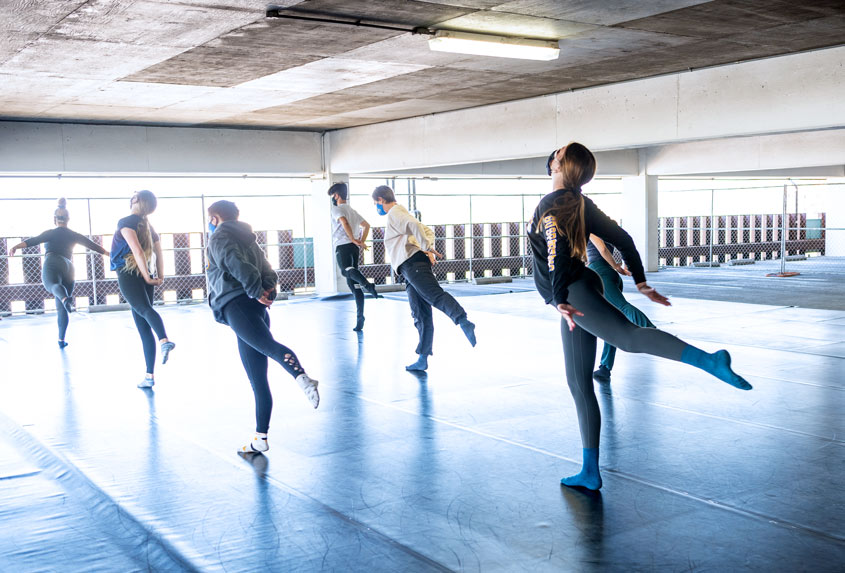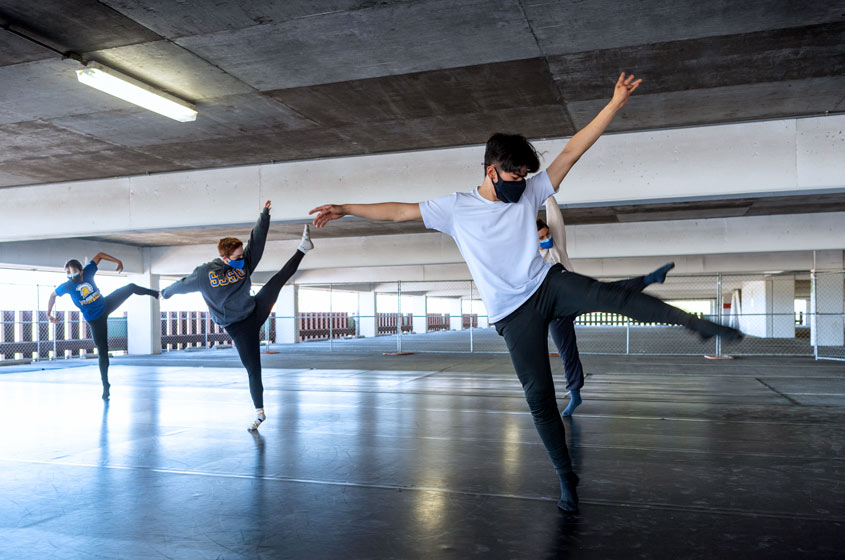The Show Must Go On
By Julia Halprin Jackson

Photos: Robert Bain
Theater, Dance, Music and the Arts Transform at SJSU During the Pandemic
Four masked dancers clad in black and white ascend the concrete steps outside San José State’s Student Union Theatre under an overcast sky. Each dancer interacts with the concrete in his or her own way, alternately resisting or springing off the wide steps.
They open their arms wide, ensuring their wingspan exceeds six feet, though each balletic movement is an act of reaching out, trying and failing to touch. San José State’s campus, normally occupied by more than 35,000 students, staff and faculty members, provides an abundance of space during the pandemic—a clean slate for the dancers, who, pre-COVID, would have performed on a single static stage.
The dancers are among those performing “Clamber,” a performance choreographed by SJSU Associate Professor of Music and Dance Heather Cooper and Raphael Boumaila, a faculty member of New York’s Peridance center. An excerpt of the fall production is included in the university’s fall 2020 online-only Kaleidoscope concert.
SJSU School of Music and Dance: 2020 Virtual Kaleidoscope
“Clamber” is a high-tech production that utilizes the entire campus as its stage. Cooper worked with SJSU’s Hammer Theatre to livestream four groups of dancers simultaneously moving across SJSU, offering the audience multiple perspectives of one large performance.
Cooper says that this experience has shifted the lens by which we traditionally view dance. In a theater, audience members would sit in one place and watch movement across one stage, but by livestreaming dancers interacting with their environment—the parking garage, the theater steps, the deserted entryway to Duncan Hall—Cooper says the dancers can offer more than one point of view at a time.
“This year has been a giant limitation study,” said Cooper, referring to a common choreography practice where dancers are asked to create pieces with specific constraints—i.e., a solo performed without moving one’s arm, etc. The pandemic has provided so many limitations that Cooper has chosen to view as creative opportunities.
“How do you make a dance where nobody can touch you, when you have to dance on concrete, where everyone has to be six feet apart and double-mask? It also opens up a new space of creativity because you discover new things.”
Cooper says that since the COVID-19 pandemic began in March 2020, her department has had to transform rehearsing and performing. Dancers were separated into small pods, class sections were split to have fewer people “on-stage” at a time, and as for the stage itself—well, space became malleable.
Thanks to support from Shannon Miller, dean of the College of Humanities and the Arts, Cooper bought a special dance platform that she transports, day in and day out, to the fifth floor of San José State’s 10th Street parking garage.
Cooper livestreams each class so students can tune in from the safety of their own homes. While most dance majors have attended at least some classes in person, those who attend online can still receive instruction, perfect techniques and access curriculum.
“The Dance department’s willingness to adapt through the pandemic really speaks to how we have transformed the arts in this time,” said Miller.
“There is a huge amount of work behind the scenes—searching for space, securing equipment, not to mention the number of hours the faculty has put in to ensure that students can still learn, practice and perform. Their commitment has been amazing.”
Creating art from pandemonium
The pandemic has forced artists worldwide to rethink how, when and where they create. SJSU dancers have had the chance to continue rehearsing, thanks to Cooper’s ingenuity.
In fall 2020, the College of Humanities and the Arts launched Pandemic Pandemonium, an initiative designed to reflect and take visible action about the role of artists and thinkers across disciplines. The project focused on four themes: resilience, social justice and democracy, health and well-being, and language and thought.
Faculty across disciplines were encouraged to incorporate these themes into their curriculum. In February 2021, the college hosted an online showcase to recognize student submissions in each of the categories, from spoken word and public service announcements to 3-D mask designs, original music, dance, theater and art.
Jasmine Marie Reyes, ’21 Vocal Performance, was one of two soloists performing “Ella’s Song” by Bernice Johnson Reagon with the SJSU Choraliers and the Concert Choir. The piece is featured both in Pandemic Pandemonium and in the fall 2020 Kaleidoscope virtual performance.
The performance, which combines recordings of individual singers in their own homes, shows the faces of each singer and juxtaposes the refrain, “We who believe in freedom cannot rest until it comes,” with images of George Floyd, Ahmaud Arbery, Sandra Bland, and other Black lives lost to police violence.
SJSU Choirs perform Ella's Song by Bernice Johnson Reagon
“We chose the song for its amazing message of social justice and the work that we all still have to do in order to achieve a more equitable and just society,” said Jeffrey Benson, director of choral activities at SJSU. “It was hours of work to put it all together—and much less fun than singing together in person—but completely worth it to sing a work of such power and beauty.”
Reyes agrees that recording this way is a departure from regular in-person rehearsals and performances, but she said she is grateful for the opportunity to build new skills.
“I had to learn how to edit sound using a digital audio workstation (DAW) called ProTools,” said Reyes, whose most recent single, “Lead Me Home,” is available on Spotify and Apple Music.
“I had never needed to know about the production side of music, but it was so eye-opening and helpful. It definitely helped me grow as a musician.”
The artistic reinvention of space

While individual artists like Reyes have had to adapt their own artistic practices during COVID, theater and performance spaces have had to make institutional changes to stay afloat. Just ask Chris Burrill, executive director of SJSU’s Hammer Theatre.
When shelter-in-place orders were formalized in March 2020, the Hammer was midway through a successful spring season. The Swiss mask troupe Mummenschanz was scheduled to perform in mid-March, but once Burrill saw the county orders to cancel in-person gatherings, he arranged a livestream of the show in the theater, which was made available to ticket holders.
“Mummenschanz has been around for decades and never allowed anyone to stream or record them,” he says. “Not only did they let us stream them, but ours ended up being the last show of their 2020 tour.”
Burrill says that the Hammer had no choice but to pivot. To go from a bustling venue, full of patrons, artists, stagehands, employees, food service workers and community members to an empty hall overnight was heartbreaking, but it wasn’t the end.
“Our core business is presenting events where people sit together and see, hear and watch art,” he said.
“That makes the experience what it is. You can’t replace that with streaming, but we can use streaming to access people who can’t come or to support events that are sold out. We’ve transformed from a live venue into a provider of high-quality livestreamed and recorded performances.”
He adds that of the thousands of SJSU students who ordinarily occupy campus, many of the students who have remained on or near campus during the pandemic are either performers or athletes.
“Someday our actors and dancers will tell their grandkids a story about how they got to be onstage at a virtually deserted university during the pandemic,” said Burrill.
“They were able to participate in a play or a dance because SJSU and the Hammer were transformative. We pivoted. Let’s make lemonade out of lemons, for crying out loud.”
In summer 2020, the Hammer launched a crowdfunding campaign that partially funded the purchase of a four-camera, high-definition digital video system, complete with a 40-foot wide, 25-foot tall green screen that allows images to be digitally inserted behind performers and speakers. The theater’s robust COVID-19 protocol and studio/livestream capabilities provide solutions until in-person events are feasible.
As venues across the county, state and country slowly begin to reopen as surges in the pandemic decrease, artists at San José State will continue to adapt. Challenging as it has been to produce music, art, dance and theater during COVID, Cooper remains hopeful that the Spartan artistic community will thrive.
“Throughout history, some of the greatest art has come out of adversity,” she said.
“Suddenly, things aren’t as comfy as they were before. We don’t have the same luxuries. I think going through these challenges inside a community of people can lead to really powerful, meaningful work in the arts. It will be interesting to follow that path and see what artists make.”